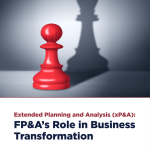In this series of blogs, based on the recent webinar “XP&A in action: Enhancing FP&A Agility with...

Extended Planning & Analysis, xP&A, is the evolution of financial planning beyond the finance function. It requires planning highly integrated with other business functions, a transformation of analytics, and a business partner culture, which combined lead to the requirement for modern FP&A skills in the workforce.
In two articles, based on the recent webinar "XP&A in action: Enhancing FP&A Agility with Supply Chain Planning", I will discuss the future of xP&A and supply chain planning. This second article will focus on autonomous planning and the finance professional's role. The first article of this series is available here.
A Journey Towards Autonomous Planning
Analogous to the emergence of autonomous physical assets in the supply chain is the momentum toward autonomous supply chain planning, also known as 'light-out planning' or 'touchless planning.'
In reality, enterprise reporting and decision-making are still tied together by spreadsheets, with over 90% of companies dependent on them. FP&A professionals still spend significantly more time gathering and generating information than decision-making. Indeed, 60% of voting xP&A webinar participants indicated that "problems with systems and processes" are the most significant barrier to effective FP&A and supply chain integration in their organisation. We're a far cry from autonomous planning.
Today, supply chain planners are still supported mainly by Enterprise Resource Planning (ERP) systems and Advanced Planning & Scheduling (APS) systems. Financial professionals are supported by cloud FP&A solutions to collaborate, budget, plan, and forecast. Both planning functions use additional Business Intelligence (BI) systems to provide insights and perform tasks.
But autonomous planning can't be achieved by these systems alone.
Key Features of Autonomous Planning Systems
Autonomous planning systems provide finance with the following capabilities*:
-
A common planning and analytics data layer
As Nathan Goldstein from Wolters Kluwer highlighted in the webinar,
"The most important part of integration is bringing siloed data into a common data layer to support planning use cases."
This data layer solves information shortcomings in large global enterprises that run disparate systems but lack a common database. The common data layer should only use relevant planning data from appropriate sources – with minimum latency and maximum detail, security, and responsiveness. It must be able to read multiple data sources and dynamically update those sources if required.
-
A Digital Twin to Model the xP&A and Supply Chain Planning Process
To fully automate any process, digitisation is required. The planning technology must know the steps, decision points, and communication channels for sharing decisions and outcomes. This is the definition of a "digital twin" for planning. The scope of the digital twin depends upon the scope of the value chain being planned.
- Automated Advanced Analytics
Descriptive, predictive, and prescriptive analytics must support every decision in the digital planning process. Prescriptive analysis (how can I make it happen?) will select the best course of action from the predictive analysis based on a defined business goal and probability analysis.
- Automated and Dynamic Problem-Solving and Decision-Making
To achieve truly autonomous planning means eliminating the human planning role. The system's problem-solving and decision-making capabilities must improve human reasoning, judgment, and creativity.
- Flexible Budget and Goal Setting
As smart as problem-solving algorithms may become, they still need a goal. What do we optimise in a decision? Function, business, or value chain? Do you maximise customer service or profit and minimise costs? Or do you aim for something else? Goals can change during economic and product life cycles and don't always have to be logical. A business logically wants to optimise EBIT but might decide to incur losses to gain market share.
- Automated Execution
Planning decisions in the supply chain need to be automatically executed. Planned orders must become production, stock transfer, or purchase orders. Rescheduling decisions are required to update due dates on the factory floor or the supplier.
Covering all the functionality described in an integrated platform on a global scale might sound impossible. However, we are also starting to see the first examples of autonomous systems replacing the human planning process. We also see that finance professionals use decision intelligence to augment their decision-making with predictions, insights, and recommendations.
A Changing Role of the Finance Professionals
Visualising a future supported by more autonomous planning, we foresee a change in professionals' many roles in the supply chain and finance.
- Information role
Data gathering, cleansing, manipulating, mastering data, and planning parameter maintenance will be largely automated.
- Analytics role
Descriptive and diagnostics analytics will be automated and always available for xP&A and supply chain stakeholders. We'll see the rise of a planner as a citizen data scientist. The information and analytics role now takes 30%-50% of a planner's time — valuable time that the planner will get back.
- Planning & forecasting role
These processes will be primarily digitised and automated with the help of a digital twin. A planner's role will shift to using technology to maintain the process, goals, and targets to guide the digital twin.
- Interpersonal role
Maintaining cross-functional and strategic alignment as a business partner remains key to a planner's role. Finance and supply chain professionals will have up to 40% more time for all the human things they don't have time for now – activities like coaching and human strengths like strategy, innovation, and emotional intelligence, among others. Deloitte estimates that over 30% of highly paid jobs are social by nature. And McKinsey estimates a 24% rise in social and emotional skills demand by 2030.
- Decision role
Planners will transition from what is now essentially an information and analytics role to a decisive role. More minor planning decisions (frequent/lower value) will be automated. Recommendations will support more significant decisions through decision intelligence. Automated and human decisions will be digitised to learn from them. Teams will be incentivised to improve speed, value, and quality of decision-making. Paul Mol echoed the need for decision agility from Electrolux, who sometimes challenges his team to give him a one-day answer for what can be a complex problem. This forces the team to make decisions with imperfect data under imperfect circumstances, prevents analysis paralysis, and drives a mindset of agility.
- Automation role
A new planning role that will emerge is the automation role. Both the planning process and decisions will be automated where possible. Intelligent automation will identify variations and gaps to plan and automatically action these up to a defined threshold. Above that threshold, it provides recommendations humans must decide upon. It becomes the planner's role to determine the automation thresholds with other business functions and maintain these in the digital twin.
The change in roles is good news for FP&A and supply chain planners. Not only will they get more effective planning and decision-making processes, but they will also get a much more interesting and engaging job. They will have more time for business partnering and value-adding activities.
A New Organisational Mindset
The transition to more autonomous planning and decision-making requires a new mindset for the enterprise and the planner. Enterprises need to rethink the impact of intelligent automation on their operating models, organisational designs, skill sets, and incentives. Planners will need to keep an open mindset to learn new skills, transition to a decision role, and work with technology to provide automation.
Companies need to make data, automation, and decision intelligence part of an updated vision. Digital natives, like Amazon, whose culture is already data-centric, focusing on automation and Artificial Intelligence, have a natural advantage. Non-digital natives must drive this new culture from the top down. This is not easy. 92% of executives indicate cultural obstacles are the greatest barrier to becoming data-driven. But it is happening.
Take the example of a 90-year-old CPG giant with 2.5 billion daily customers, 161,000 employees, and 300 production facilities across 190 countries. Its CEO has put digital transformation at the heart of its strategy. Its Chief Supply-Chain Officer has publicly declared that investing in decision agility, which he defines as quickly sensing and responding to change, gives a tenfold return than investing in forecasting and Scenario Planning.
This company has a clear vision of applying decision intelligence. It has pledged "to find the hundred decisions that we make within the supply chain — decisions that drive 80% of our activity — and automate them over the next two years." In terms of decision-making structures, it has clearly defined where its people are in the loop (the active part of making decisions), on the loop (only observing and guiding), or out of the loop (not part of the decision-making process). In terms of its organisational structure, it has a machine reporting to a human, promoting human-machine collaboration.
Automation will not overtake humans. The machine will still require human guidance. Kasparov's law dictates that the combination of ordinary humans and ordinary machines using the right processes can lead to superior performance, triumphing over human genius or powerful computers alone.
The human stays central in the future of planning, but its role will undoubtedly change.
* Autonomous or 'Lights Out' Supply Chain Planning; what is really required? Foresight 2019, Niels van Hove
This article was first published on the Wolters Kluwer blog.
Subscribe to
FP&A Trends Digest

We will regularly update you on the latest trends and developments in FP&A. Take the opportunity to have articles written by finance thought leaders delivered directly to your inbox; watch compelling webinars; connect with like-minded professionals; and become a part of our global community.



